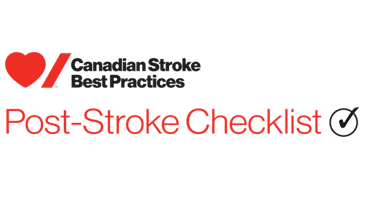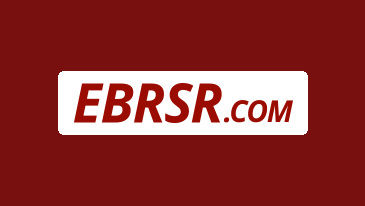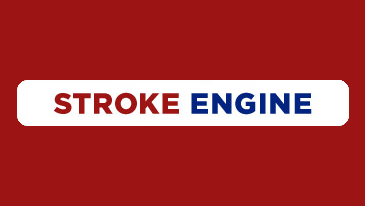- Definition and Considerations
- 1. Supporting People with Stroke, Their Families and Caregivers
- 2. Education for People with Stroke, Their Families and Caregivers
- 3. Interprofessional Care Planning and Communication
- 4. Community Participation Following Stroke
- 5. Transition to Long-Term Care Following a Stroke
- 6. Post Stroke Depression
- 7. Post-Stroke Fatigue
Section 2: Education for People with Stroke, Their Families and Caregivers
6th Edition - 2019 UPDATED
Recommendations
2.0 Education for people with stroke, their families and caregivers, is an integral part of stroke care that should be included as part of all healthcare encounters, and during transitions [Evidence Level A]. Individualized educational needs change over time and may need reassessment and updating on an ongoing basis [Evidence Level B].
2.1 Assessment of Learning Needs
-
Individualized learning needs and goals should be assessed and documented by members of the healthcare team [Evidence Level B]; and updated regularly as people move through the stages of care following stroke [Evidence Level B].
Note: This applies to all settings including ambulatory care and emergency departments where there is shorter interaction time and greater risk of learning needs being unmet.
2.2 Delivery of Education
-
An individualized education plan should be developed and implemented based on the assessment of learning needs and goals of people with stroke and their families [Evidence Level B].
-
It is recommended that the individualized education plan:
-
Cover all relevant aspects of stroke care and recovery [Evidence Level A], and include content specific to level of readiness and setting and stage of care [Evidence Level B]. Refer to Table 2: Core Education across the Continuum for People with Stroke.
-
Be goal-oriented and facilitate shared decision-making regarding care and recovery [Evidence Level B].
-
Include information sharing, teaching of self-management skills, and training of family and caregivers to participate in and provide safe stroke care [Evidence Level B].
-
Be interactive, evidence-based, accurate and available in a variety of languages and formats (e.g. written, oral, pictorial, instructive, and group counseling approaches); it should address varying levels of health literacy and be accessible for people with aphasia and cognitive deficits or impairments [Evidence Level A].
-
-
Education provided should be documented in the health record and accessible by all members of the healthcare team [Evidence Level B].
-
Assess and document understanding and retention of information regularly [Evidence Level A].
-
Include reinforcement of information that has not been retained (e.g., medication information and management) [Evidence Level B].
-
Education and information for people with stroke, family and caregivers should be provided both formally and informally in individual and group settings as appropriate [Evidence Level B].
-
Family and caregiver education, hands on training, and skills development should be provided using an interdisciplinary approach based on the individual’s learning needs [Evidence Level A].
2.3 Supporting Self-Management Following Stroke Through Skills Training
Refer to Definitions and Descriptions within the Introduction and Overview for the definition of self-management.
- Self-efficacy can be supported by providing opportunities to learn and master self-management skills [Evidence Level B]. Refer to Box 2 for additional information regarding self-management topics for people who had a stroke, their family and caregivers.
- With consent, family members and caregivers may be invited and encouraged to attend care and therapy sessions and given the opportunity to learn proper skills to support self-management [Evidence Level C].
- All care settings should have up-to-date inventories of community resources available to support self-management and offer guidance and assistance in obtaining needed services [Evidence Level C].
- People with stroke, their families and caregivers should be provided with resources and information which will enable self-management and the ability to navigate through the health care and social system [Evidence Level B].
Education topics:
- secondary stroke prevention
- medication management
- risk factor management (including adherence to pharmacotherapy)
- role and importance of exercise, information on community-based exercise programs
- symptom and stress management techniques
- fatigue, sleep management, and energy conservation strategies
- nutrition, healthy eating strategies
- coping with physical changes
- coping with emotions such as fear, anger and depression
- coping with cognitive and memory changes
- coping with perceptual deficits
- health-related problem-solving and decision making
- relationships, intimacy and sexuality
- community participation and resuming valued activities
- leisure and social participation
- supports available in the community, such as housing/supported living options
- driving regulations and rehabilitation, and community-based transportation services
- considerations and strategies related to return to work
- financial resources
- advanced care planning, end-of-life and palliative care options
- respite care options
- peer support
Skills training and self-management topics:
- Self-management education to encourage independence, increase confidence and skills to better manage their health
- Personal care techniques (e.g., feeding and bathing techniques)
- Communication strategies and supportive communication
- Safe transfers, lifts, and repositioning (e.g., transfers from bed to chair, positioning of a hemiplegic limb)
- Food preparation and modifications for dysphagia
- Cognitive strategies such as problem-solving techniques
- Stress management techniques (e.g., exercise, mindfulness and meditation)
- Accessing community services and resources
- Ongoing health system navigation
- Awareness of the importance of self-care and caregiver burnout
Education is an ongoing and vital part of the recovery process for persons with stroke, family members and caregivers. Research demonstrates that persons with stroke generally retain less than 25% of information and education provided in hospital. Education about stroke facilitates better understanding and supports coping and self-management, and must be repeated and reinforced with consistency across transitions of care. Skills training for caregivers may increase participation and safety, clarify expectations, improve quality of life, and reduce depression and perceived burden. The information provided at each phase of acute care, rehabilitation, community participation, long-term recovery and end-of-life should be relevant to the person with stroke and the family’s changing needs. Simple distribution of pamphlets is not sufficient; the delivery should be interactive and adapted to the cognitive and communication challenges faced by some people following stroke, including receptive and expressive language, processing speed, hearing, or visual impairment.
People with stroke emphasized the importance of an inclusive process by involving themselves and their family members in conversations where information is relayed by healthcare team members. However, they have reported that they were not always able to retain the information given to them due to multiple reasons, such as exhaustion and denial. They describe that it was helpful to receive a package containing copies of all this information in one place that they can review when needed. Examples of information that people with a lived experience of stroke, their families and caregivers specifically noted as useful or would have liked to have had includes a summary of health information, contact numbers, available resources, and information to address financial challenges and funding opportunities.
Transitions of care support and actions are applicable across the continuum of care, including in primary care, the emergency department, acute care, rehabilitation settings, complex care/transitional bed settings, long-term care and community settings. Processes and mechanisms should be in place in all these settings to address educational needs of the person with stroke, families and caregivers, including:
- Coordinated efforts among stakeholders such as the Heart and Stroke Foundation, Canadian Partnership for Stroke Recovery, public health agencies, ministries of health, non-government organizations (NGOs), hospitals and clinics, and individual care providers across the continuum of stroke care to produce education materials with consistent information.
- Community resources, such as stroke recovery support groups, to provide ongoing support and education following hospital discharge.
- Coordinated processes for ensuring access to and awareness of educational materials, programs, activities and other media related to stroke by healthcare professionals, persons with stroke and caregivers, including advertising the availability of educational material, effective dissemination mechanisms and follow-up.
- Coordinated processes for ongoing communication between departments/organizations/agencies of learning needs and education that has been provided.
- Access to training for care providers learn communication strategies for aphasia.
- Access to educational resources that are culturally, ethnically, and linguistically appropriate.
- Access to self-management support services through telemedicine technologies, especially in rural areas and where there are local resource gaps.
- Training of healthcare providers in self-management skills that they can then share with people with lived experience.
- The development and implementation of an equitable and universal pharmacare program, implemented in partnership with the provinces, designed to improve access to cost-effective medicines for all people in Canada regardless of geography, age, or ability to pay. This program should include a robust common formulary for which the public payer is the first payer.
Clinical and Health System Performance Measures:
- Proportion of persons with stroke with documentation of education provided at each stage throughout the stroke management and recovery process (core).
- Total number of encounters focused on education for each person with stroke, and the time spent on education during a healthcare encounter for stroke.
- Percentage of persons with stroke discharged with a copy of their discharge plan and educational materials.
- Change in self-management behaviour at 6 weeks, 3 months and 6 months following stroke, using validated measurement tools.
Person-Oriented Measures (PREMS, PROMS)
- Change in person with stroke and family knowledge of stroke-related content before and after teaching session.
- Changes in quality of life measured at regular intervals during recovery and participation, and reassessed when changes in health status or other life events occur(e.g., at 60, 90- and 180-days following stroke).
- Percentage of people with stroke who reported feeling adequately prepared for self-care and self-efficacy.
Measurement Notes
- Quantity and method of education are very important elements of this recommendation. Measurement of education for persons with stroke and families should be expanded when feasible to capture these aspects, although this is challenging to accomplish.
- For Indicator #3, here possible, standardized mechanisms for testing person with stroke, family and caregiver knowledge pre- and post-education should be included in the education sessions.
- Data sources include all documents, charts, and records related to care across the healthcare system (primary care, acute care, follow-up clinics, inpatient and outpatient rehabilitation programs, community programs and services) and may be obtained through primary chart audit or review, and various logging and audit practices of individual groups.
- Documentation quality (generally weak) by healthcare professionals involved in the persons care may affect ability to monitor this indicator reliably.
Health Care Provider Information
- Taking Action for Optimal Community and Long-Term Stroke Care: A resource for healthcare providers
- Accreditation Canada Stroke Distinction Program
- Timing it Right study (Cameron & Gignac 2008)
- Aphasia institute
- Transitions between hospital and home (Quality Standards from Health Quality Ontario)
Resources for People with Stroke, Families and Caregivers
- Taking charge of your stroke recovery: Rehabilitation and recovery infographic
- Taking charge of your stroke recovery: Transitions and community participation infographic
- Your Stroke Journey: A guide for people living with stroke
- Post-Stroke Checklist
- A Family Guide to Pediatric Stroke
- Heart & Stroke Services and Resources Directory
- Heart & Stroke Recovery and Support Health Information
- Canadian Partnership for Stroke Recovery Patient Resources
- Stroke in Young Adults
- Stroke Engine
- Transitions between hospital and home (Patient Guide from Health Quality Ontario)
- Taking charge of your stroke recovery: 2020 Virtual healthcare checklist infographic
Evidence Table and Reference List
Education across the continuum of care is an important component of support for patient, families and informal caregiver, particularly with regard to secondary stroke prevention and chronic disease self-management. A 2012 Cochrane review (Forster et al. 2012) assessed interventions related to the provision of information, compared with usual care and included the results from 21 RCTs. In 14 trials, the intervention was focused on either the patient or carer exclusively. In the remaining trials, the intervention was focused on both groups. Patients and caregivers receiving an intervention had improved knowledge of stroke services and patients expressed greater satisfaction with stroke information compared to patients in the control group. Patients receiving an intervention also experienced improvements in depression scores (MD=-0.52, 95% CI -0.93 to -0.10, P<0.05) with greater effects associated with interventions that were considered “active”, meaning there was patient or carer engagement during the sessions. Engagement could include the opportunity to ask questions, request additional information, be provided with hands-on training, or involve the use of an interactive workbook and/or some means of follow-up reinforcement.
Several randomized trials have evaluated the effects of information and support packages for patients and their caregivers following stroke. Those trials that simply provided participants with written information as the intervention tended to be less effective compared with programs that included additional components. Eames et al. (2013) randomized 138 patients and their carers to receive an individually tailored education and support package with verbal reinforcement for 3 months, or to a usual care group, which received unstructured, informal education. Patients in the intervention group reported significantly greater self-efficacy (access to stroke information domain, p<0.04), feeling of being informed (p<0.01), and satisfaction with medical (p<0.001), practical (p<0.01), service/benefit (p<0.05), and secondary prevention (p<0.001) information received. Lowe et al. (2007) evaluated the use of a “CareFile”, an information package containing relevant support services and secondary prevention resources that was individualized for each patient. One hundred patients participated in the study, 50 randomized to the intervention group and 50 to the control group. At six months, 98% patients in the intervention group reported that the CareFile provided useful information and 53% said that they used it as reference material regarding their stroke. Patients in the intervention group demonstrated greater knowledge of stroke risk factors than patients in the control group at both 3 and 6 months after stroke. Hoffman et al. (2007) randomized 138 patients to receive either computer-generated tailored written information or generic written information. At three months, there were no significant differences between groups in mean change scores for stroke knowledge, self-efficacy or depression.
Telephone- based interventions have also been examined as a method of providing support and education, Bakas et al. (2009) randomized 50 caregivers with ongoing needs to a Telephone Assessment and Skill Building Kit (TASK) group or to a usual care group. Participants in the TASK group received a notebook containing skill building tips, a stress management workbook and a brochure on family caregiving, plus weekly phone calls from a nurse for a period of 8 weeks that involved discussion of patient identified priority areas. Participants in the control group received a brochure on family caregiving, as well as weekly calls from a nurse who did not provide any advice or information Caregivers in the intervention group were significantly more optimistic at 4, 8 and 12 week follow up, experienced significantly lower levels of task difficulty at 4 weeks and had significantly improved threat appraisal skills at 8 weeks and 12 weeks, although there were no significant changes in depressive symptoms, life changes or general health perception.
Studies assessing the impact of caregiver education and skills training have also reported the benefits of active or “hands-on” interventions. A randomized controlled trial by Kalra et al. (2004) allocated patient/caregiver dyads to receive structured caregiver training (hands-on training in basic nursing techniques that emphasized skills essential for daily management of ADL) or conventional instruction (information and advice). The length of the intervention was dependent on patient need, ranging from three to five sessions in the inpatient rehabilitation setting. Patients experienced reductions in anxiety and depression at 12 months (p<0.001) and increased quality of life at 3 and 12 months (p<0.05). No differences between mortality, institutionalization or functional ability were reported between intervention and control groups. Using a similar intervention, Forster et al. (2013) randomized 928 patients, expected to return home following acute stroke, to participate in the London Stroke Carers Training course (LSCTC) (same protocol as Kalra et al. 2004), or to usual care. At 6 months there was no significant difference in the mean patient Nottingham EADL scores between groups (27.4 vs. 27.6, p=0.866) or Caregiver Burden Scores (45.5 vs. 45.0, p=0.660). While the intervention did not appear to be effective, the authors speculated that the timing, in the immediate period after stroke, might not be ideal.
The implementation of education and skills training programs ultimately aim to increase the self-efficacy of patients and informal caregivers for their own self-management. Lennon et al. (2013) conducted a systematic review of studies (including randomized and non-randomized controlled trials) that assessed “self-management” interventions for patients recovering from stroke. Interventions included in the review were quite variable, ranging from group programs to one-on-one interventions consisting of workbooks, DVDs or exercise sessions. Several interventions were based on the Stanford Chronic Disease Self-Management programme, which consists of workshops, a companion book and a relaxation CD. However, due to the variability in outcomes assessed, pooling of results was not possible. Some of the largest randomized controlled trials included in the review demonstrated improvement in physical domains, quality of life, and dependency. A Cochrane review (Forster et al. 2007) included the results from 18 studies examining self-management programs for participants with multiple chronic conditions (e.g. arthritis, chronic pain, stroke, hypertension, heart failure etc.). There were small but statistically significant improvements in pain, disability, fatigue and depression and anxiety associated with the intervention group. There were also small but statistically significant increases in levels of exercise and in the frequency of practice of cognitive strategies for symptom management associated with the intervention.





